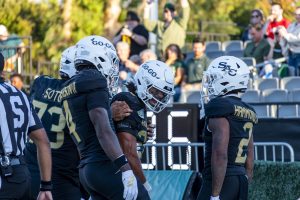Students value diversity in education
May 3, 2015
As of fall 2014, Sacramento State’s student population breaks down into 35 percent white, 22 percent Latino, 21 percent Asian, six percent African-American, three percent foreign, one percent Pacific Islanders as well as American Indians, and 11 percent other, or multiracial.
CollegeFactual.com ranked Sac State number 25 nationwide for ethnic diversity.
As a supporter of multicultural education, Sac State’s College of Education hosted its 21st annual Multicultural Education Conference on Saturday, April 25. This year’s theme was “Identity and Experience: Intersections in Multicultural Education.” The conference focused on topics such as LGBT inclusion in schools and bilingual education.
The Sac State community is a prime example of how diversity in an educational setting can help foster a sense of acceptance and inclusion for all people. With over 100 clubs with varying cultural, recreational and religious affiliation and numerous Greek and special interests clubs, diversity sprawls across every corner of Sac State and is highly valued by students and faculty.
“Diversity is a fantastic thing to have because you get to learn about new cultures and learn about new perspectives,” said Viral “Victor” Patel, a senior human resources major. “It broadens your horizons. It is great because you can have an understanding of people and that can lead to greater understanding of the world. It can bring peace in a way because you can understand the person.”
Diversity in an educational setting not only helps to encourage acceptance for all, but it enables people to learn about themselves. Jess Schutzmann, a transfer psychology major, believes diversity is essential to education and personal growth.
“Even beyond the whole ethnic aspect, there are different ideas,” Schutzmann said. “By having diversity, you are able to have some sense of what your weaknesses and strengths are. You can collaborate with other people. If you didn’t have all those different stimulations and ideas, then what more could you learn about yourself than what you already have?”
The eclectic mix of students and faculty at Sac State encourages the community to connect with each other and expand their horizons. There are so many ways to take advantage of the diversity that makes up Sac State and its surrounding communities.
Aundrey Mosley, a first-semester transfer majoring in communication studies, feels that the diversity at Sac State helps expand faculty teaching methods.
“You’re not projecting it towards a group of people or one type of person or culture,” Mosley said. “You are constantly finding different ways to educate because you have so many different types of people, so many different types of ways people learn. If you just had one culture, you would ultimately have one style or way of teaching. It makes us more well-rounded.”
John Gilgun, a communication studies professor, agreed the diversity at Sac State influences his teaching style and the atmosphere in his classes.
“I love the multiple perspectives,” Gilgun said. “The socioeconomic levels, the different cultures, the different experiences, when people open up, it just generates almost mind-blowing discussions.”
It is when the view of another person is taken into account that true growth and understanding happens. The college experience, and education at any level, is not simply about academia. It is about taking in all the experiences and opportunities that arise from participating in panel discussions, learning about a club on campus, exploring a new interest and talking to peers and faculty of various cultures and backgrounds.





















































































































